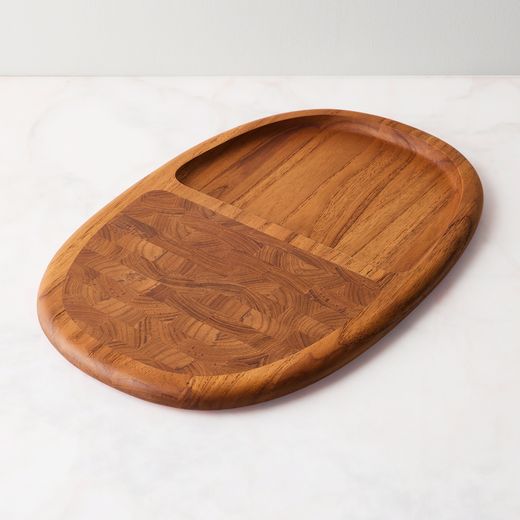Entertaining
Cheese Board 101: How to Build the Perfect Plate
A primer on presentation and cheese selection, plus tips on tools.
Many of us are obsessives when it comes to cheese, but the thought of composing a balanced cheese plate is daunting. What's the best surface for serving cheese? What is the difference between all those little knives? How many cheeses should I choose? Variety is important, but at what point will my taste buds get overwhelmed? Can I mix and match different regional varieties? Which cheeses pair well with the wine I’m serving?
To calm our cheese board insecurities, we turned to Christopher Hanawalt, former cheesemonger of Brooklyn’s famed Bedford Cheese Shop. He shared invaluable insights on how to pick the perfect selection of cheeses, reassuring us that cheese board curation is far from a rigid art. The most successful selections stem from a set of basic guidelines, but ultimately rely on a heavy dose of personal creativity.
Variety, variety, variety. “Take advantage of the range of milk types, textures, intensities, colors, and shapes that cheese comes in to create a cheese board that is both visually interesting and tastes exciting and new.”
Curate by milk type. “A basic approach to creating a good range of cheeses is to get three cheeses of different milk types: a cow’s milk, a sheep’s milk, and a goat’s milk. That is the foundation for creating a great cheese plate. There is nothing more unappealing than a plate of different bries or four different aged goudas sitting on a board. Our taste buds get bored quickly and easily, and demand to be entertained.”
Consider texture, intensity, and visual appearance. “Choose some cheeses that are mild, some cheeses that are stronger, some cheeses that are soft, some cheeses that are harder and more rustic. And since half of good eating is presentation, it's important to get cheeses that simply look different from one another! Cheeses come in a veritable rainbow of hues and all sorts of weird shapes and sizes. Get crazy!”
Consider wine pairings. “For white or sparkling wines, I prefer creamy, buttery, spreadable cheeses, such as bries, or fresh chèvres. Whites also pair excellently with blue cheese and more pungent cheeses. The acid of a white wine is a great way to cut the palate-coating creaminess of these cheeses. For red wines, I prefer harder, nuttier, grassier cheeses, such as pecorino, alpine-style cheeses (Comté, Gruyère, Appenzeller, etc.), or cheeses from the Pyrenees. These cheeses are able to stand up to the tannins of a red wine, which produce unique flavors in both the food and beverage. If you do want to do a creamier cheese with a red, I would recommend something earthy, spicy, and barnyard-y—something that smells like a wet sheep lying on a bale of hay. (You’ll be pleasantly surprised!)
That said, there are definitely no rules when it comes to pairing. You should never be stressed out when it comes to eating good food especially something as special as seasonal, farmstead cheese!”
So you’ve been eyeing those all the cheese boards and cheese knives in the Food52 Shop. Distinctive and dramatic, they turn eating cheese into a cause for celebration. To help you choose the perfect tools, here are some parameters:
Bulky butter knives belong on the right side of the dinner plate, not on your cheese plate. A set of cheese knives typically includes one with pointy end to break and grab chunks of hard cheese; a sharp, one shaped like a mini axe for slicing; and a spreader for, well, spreading.
You'll also need a board on which to artfully arrange your cheeses. We like cold surfaces like marble—they keep the cheese from getting droopy and mopey. But we can't say no to a rustic, wood surface, either.
For a finishing touch, you could use labels to help your guests identify what cheese they’re eating. We would gladly eat any cheese put in front of us, labeled or not, but it’s nice to know for several reasons: One, if your guest absolutely loves your pick, they'll know the name for their cheese buying. And two, if they don’t eat unpasteurized cheese, you can label them as such. Writing names on a little washi tape and sticking it directly onto the board works.
If you need a little boost to start, here are Chris’s suggestions to help you navigate the stinky terrain during your next visit to the cheese shop:
Pick #1: Soft-ripened, washed rind cheese
These pungent, soft cheese are perfect for scooping onto crusty bread. All of these cheeses come in a round, are designed to be gooey, and can be paired with sweeter white wines or lighter reds. They lend themselves to pickles, jams, salamis, and olives excellently.
- Vacherin Mont D'or (from the Alps)
- Rush Creek Reserve (Upland's Cheese in Wisconsin)
- Epoisses (from Burgundy, France)
Pick #2: Firm goat’s milk cheese
Fresh goat cheeses are not in season during the winter, as animals are moved indoors from their pastures. Because of their age, these firm cheeses pair well with a variety of wines, beers, and liquors.
- Caprotto (a goat's milk made in a pecorino style from Italy)
- Garrotxa (an earthy cheese from Spain)
- Firmer cheeses from Haystack Mountain in Colorado, primarily the Queso de Mano or Sunlight
Pick # 3: Sheep’s Milk or Blue Cheese
Sheep’s Milk Cheese
- Spanish cheeses which are more aged, such as Manchego, Zamarano, or Roncal
- Sheep's milks from the Pyrenees
- French mixed milk Gabietou
Or, if you want something stronger and softer...
Blue Cheese
- Colston Bassett Stilton from England
- Bleu d'Auvergne from France
- Any of the blues from Rogue River Creamery in Oregon
More cheese board inspiration from Food52
- Our Food Stylist’s Tips for the Best Thanksgiving Cheese Board
- Our Favorite Cheese Board Combos for Easy Grazing
- How to Make Charcuterie Actually Look Cute on a Cheese Board
- 4 Actually Useful Cheese Board Tips














See what other Food52 readers are saying.